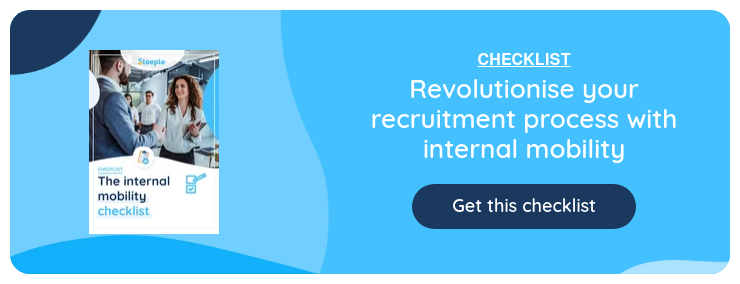Published on 16/05/2024
Would you like to change jobs without changing companies? Applying for a new job? Internal mobility is THE solution for developing your career without returning to the job market.
While this request for a change of job meets a need for change on the part of the employee, it also offers a number of advantages to the company:
- Improving the employee experience
- Reduced recruitment costs
- Onboarding made easy
- And so on.
Internal mobility involves a number of different stages:
- Searching for a vacant position
- Information gathering
- Forwarding your request to your line manager
- The use of an internal communication tool is ideal for facilitating the internal mobility process.
Here's our advice on how to apply successfully for a change of job within your company. And therefore your request for internal mobility.
#1 - Why apply for a change of job: the internal mobility solution
Internal mobility can take many forms and can be desired for a variety of reasons.
a) The 3 types of internal mobility: vertical mobility, horizontal mobility and cross-functional mobility
A change of job within the company may be possible:
- Vertically: for example, an employee receiving a promotion within the same department, which translates into more responsibilities and a pay rise.
- Horizontally: the employee changes departments but retains a similar function.
- Transversally: the employee changes departments and gains in responsibility
b) Reasons for requesting internal mobility
A request for internal mobility may be proposed directly by the manager or expressed by the employee himself. There are various reasons for making a request. Here are a few of them.
➡️ Surpassing yourself professionally
Unused professional skills, a feeling of stagnation or the need to take on a new challenge are just some of the reasons why an employee may feel the need to change jobs.
In such cases, internal career development may be the solution for achieving their full potential at work without changing company.
➡️ Overcoming internal conflict
Conflict within a team, whether between two employees or between an employee and his or her line manager, is toxic for both the employee involved and for the company.
If simple mediation is not enough to resolve the problem, a professional transfer may be a solution.
➡️ Change your life
Applying for a change of job offers employees the opportunity to change their working environment or pace of life. For example, leaving a night shift to take up a day shift in the same company allows the employee to change pace and be more present for his or her family without leaving the company.
Companies with several offices in different regions or abroad may request geographical mobility. This type of mobility allows employees to make a radical change of life without leaving their current job.
Geographical mobility can also be requested following personal upheavals (transfer of spouse, illness, etc.).
Companies that focus on internal mobility retain their talent 60% longer.
Source : The future of recruitmen, LinkedIn (2023).
#2 - 5 tips for successfully applying for a new job
Applying for a change of job within your company is not something you can improvise. To avoid regrets and limit the risk of failure, a request for internal mobility needs to be thought through beforehand. Here's our advice.
a) Monitoring
To maximize your chances of success, we recommend that you find out more about the internal mobility process in your company, starting with the mobility charter.
Depending on the size of the company and its HR strategy (existence of a monitoring plan, training plan, etc.), it may be more or less easy to obtain agreement for an internal transfer.
b) Find out about the position you are applying for
Once you've done your homework, turn your attention to the job or type of job you want.
Find out more about the person or persons occupying this position:
- What are their qualifications?
- Is a departure from the team planned, e.g. retirement?
- Does the team need to be reinforced because of a surge in activity?
- What does a typical day look like?
Answering these questions is essential not only to finding the job that's right for you, but also to building a solid project to present to your management.
c) Using networking
Even before communicating your desire to change jobs, make yourself known! To do this, start a conversation with members of the team you want to join, strengthen your network and increase your visibility. This networking is very useful in the co-optation process.
d) Work on your Curriculum Vitae (Resume)
We recommend that you update your resume based on the information you have gathered about the skills required for the position you are seeking. For internal transfers, the logic is the same as for a traditional job search: your profile should correspond as closely as possible to that of the ideal person for the position in question.
By attaching your resume to your application, you are showing your manager that your transfer could be an asset not only for you, but also for the company.
e) Informing your manager in advance
To avoid misunderstandings and unnecessary tension, inform your N+1 of your plans from the outset. Let him or her know your intentions and explain your motivations. It's important that your manager is informed before Human Resources is, so that he or she doesn't feel taken by surprise.
Creating tension would not work in your favor. What's more, by helping you to co-construct your project, your manager can be a real asset when it comes to presenting your application to human resources.
#3 - When should I apply for an internal job change?
You've targeted the job you want, your application is ready, your N+ is informed and your arguments are clear in your head? The next step in your bid to move internally is to apply to your management for a change of job.
When it comes to timing, you have two options:
- Or tackle the subject at any time of the year
- Either wait for your annual review
In practice, given that job openings can occur at any time, we don't recommend that you wait until your annual interview, at the risk of missing out on a great opportunity.
#4 - How do you justify your application for a change of job to your supervisor?
Whether or not your request for a transfer is accepted depends of course on the company's opportunities and HR policy, but also on the arguments put forward to justify your request.
These vary according to your profile and whether or not you have the skills needed for the job you want.
Case 1: you have the necessary skills
It's the ideal situation! If you have the right skills for the job, all you have to do is submit your resume and covering letter to your manager.
The fact that you already have the skills you are looking for should be a powerful argument. It should be included in your covering letter, and you should mention it when you talk to your employer.
Case 2: training is required
Having analyzed the profile required for the position you want, do you notice a gap between the skills you have acquired and the skills required ? This does not call into question the success of your internal transfer project.
Find out more about:
- Necessary training
- The number of hours
- Possible financing
In short, be proactive and show your employer that you are fully informed and that you have mastered your subject.
“Companies need new skills at a faster rate than ever before, which means they need to help their employees evolve through skills development and internal mobility.”
Jennifer Shappley, Vice President of Talent at LinkedIn.
#5 - Applying for a job change: how do you acquire new skills?
The role of human resources in internal mobility
In addition to recruitment, employer branding, appraisal and Corporate Social Responsibility (CSR), one of the missions of the Human Resources department is training and personal development.
Depending on the company, in-house training plans may be possible. Contact your HR manager to find out if you can benefit from this support.
#6 - Applying for a change of job: the internal transfer letter
A covering letter accompanying a request for internal mobility is very similar to that of a standard application.
Certain elements must be included, such as :
- A greeting
- An introduction including the reasons for the transfer and the target position
- A paragraph outlining your know-how and skills and, if applicable, your training solutions
- A conclusion with a greeting.
Although you have a cordial and perhaps even friendly relationship with your N+1, it is important that your letter requesting internal mobility is written in a professional tone.
Applying for a change of job : what you need to know
As far as employees are concerned, this article looks at the various opportunities available for advancing professionally and developing your career. Provided, of course, that you make a convincing and motivated application for a change of job.
As far as companies are concerned, internal mobility appears to be the ideal solution for retaining experienced employees, but it is not the only one. It can also help companies that are finding it difficult to recruit talent:
- Recruit committed employees who are already aware of the company's culture and employer brand.
To facilitate this process, Steeple offers an innovative internal mobility tool: the Jobs App.
The objectives of this Jobs application are as follows:

- Offer an internal communication channel to highlight vacancies within the company for all employees to see
- Turn employees into ambassadors by encouraging cooptation
- Build employee loyalty and prevent unwanted departures
- Offer an application that manages the entire internal mobility and cooptation process
- Boost your recruitment to attract and retain talent
Would you like us to help you set up your internal mobility process or find out more about our Jobs App ?
Frequently asked questions (FAQ)
The employee experience covers the entire lifecycle of an employee within a company. It begins at the recruitment stage (onboarding) and continues until the employee leaves the company (offboarding).
It is crucial to the employee's life in the company.
Visit our dedicated page What is the employee experience?
Within a company, co-optation is when an employee recommends one of his or her contacts for open recruitment.
It has a number of advantages :
- Employees who recommend someone they know are making a commitment to the company. You can therefore be sure that he or she will propose a reliable and competent profile for the position offered.
- It reduces recruitment time. The ad doesn't have to be posted on various platforms, and HR doesn't have to spend hours searching through resume libraries.
- Finally, by reducing working hours, the company makes financial savings at the same time.
There are many advantages to using an internal recruitment application :
- facilitate requests for internal mobility
- simply share available offers
- communicating available offers to all employees
Using an internal recruitment application is a real asset for the Human Resources department. In addition to these advantages, recruitment times will be considerably reduced. It will therefore have an impact on the overall efficiency of the company, as positions can be promoted more quickly and to qualified profiles.
Discover the Jobs internal mobility application
About the author
Steeple Team
Read all the articles from the Steeple team, the experts in internal communication and employee experience.
-1.png)











